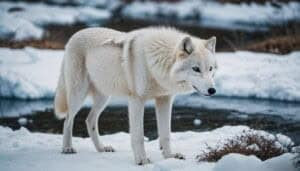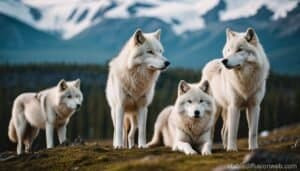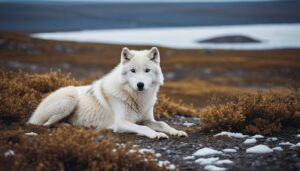Introduction
Arctic wolves face some of the harshest weather conditions on the planet. To survive, they rely on a variety of shelters that provide protection from the cold, wind, and snow
This article explores the different types of shelters Arctic wolves use, including snow dens, rocky crevices, and sheltered areas under vegetation
We’ll also delve into how these shelters are created and maintained, their effectiveness in extreme weather, and the behavioral aspects of sheltering in Arctic wolf packs
Natural Shelters of Arctic Wolves
Arctic wolves are well-adapted to their frigid environment, utilizing a range of natural shelters to protect themselves from the harsh Arctic weather. These shelters are crucial for their survival, providing refuge from extreme cold, wind, and snow
The main types of natural shelters Arctic wolves use include snow dens, rocky crevices, and vegetation and tree shelters
Snow Dens
Snow dens are among the most commonly used shelters by Arctic wolves. These dens are typically dug into deep snowdrifts, providing a warm and insulated space for the wolves to rest and take shelter from the elements
Snow dens have several advantages. The snow itself acts as an excellent insulator, trapping body heat and maintaining a relatively stable temperature inside the den, even when outside temperatures plummet. The construction of these dens involves digging a tunnel into the snow, which leads to a wider chamber where the wolves can curl up together for warmth
One of the key benefits of snow dens is their ability to protect wolves from the wind. The entrance of the den is often oriented away from the prevailing winds, reducing the amount of cold air that enters
Additionally, the snow walls of the den buffer against strong winds, providing a calm and quiet environment inside
Snow dens are especially important during the breeding season. Pregnant females use these dens to give birth and rear their pups. The warmth and protection offered by the den are crucial for the survival of the young, who are born blind and helpless and require a stable environment to grow and develop
Rocky Crevices
Rocky crevices and outcrops provide another form of shelter for Arctic wolves. These natural formations offer protection from the elements, particularly in areas where snow is less prevalent or during times when digging a snow den is not feasible
Rocky crevices serve as a barrier against the wind and provide a shaded area that can be significantly warmer than the open air, especially when the sun is shining. Wolves can often be seen resting in these crevices during the day, conserving their energy and avoiding the harsh conditions outside
The physical structure of rocky crevices also offers protection from predators and other potential threats. The narrow openings can be easily defended, making it a safe resting spot for wolves, particularly when they are with their young
Vegetation and Tree Shelters
In some regions of the Arctic, sparse vegetation and isolated trees can provide additional shelter for wolves. These natural features are less common in the open tundra but can be found in more southerly Arctic areas or near the edges of the boreal forest
Trees and dense bushes offer a break from the wind and snow, creating a microenvironment that can be several degrees warmer than the surrounding open areas. Wolves may use these vegetative shelters to rest and stay hidden from potential threats
Vegetation and trees also offer camouflage, helping wolves to blend into their surroundings and avoid detection by prey or other predators. This can be particularly advantageous during hunting or when rearing pups, as it provides an additional layer of protection
Creation and Maintenance of Snow Dens
Arctic wolves rely heavily on snow dens to survive the extreme conditions of their habitat. These dens are more than just temporary shelters; they are carefully constructed and maintained structures that provide essential protection and warmth
In this section, we will explore the techniques Arctic wolves use to create and maintain their snow dens, the insulating properties of these dens, and the seasonal maintenance they require
Digging Techniques
The creation of snow dens involves precise digging techniques that are vital for the structure’s stability and effectiveness. Arctic wolves use their strong forelimbs and sharp claws to excavate deep into snowdrifts
The process begins with selecting a suitable location, typically on the leeward side of a slope where the snow is deep and stable. This placement helps to shield the entrance from the prevailing winds
The wolves dig a tunnel that slopes slightly upward, which helps to prevent cold air from entering the den. This tunnel leads to a wider chamber where the wolves can rest. The chamber is often large enough to accommodate multiple wolves, allowing them to huddle together for warmth
The walls and ceiling of the den are compacted to ensure structural integrity and to reduce the risk of collapse
Insulating Properties
One of the most remarkable aspects of snow dens is their insulating properties. Snow is a natural insulator due to its composition of ice crystals and trapped air. This unique structure helps to maintain a stable temperature inside the den, often significantly warmer than the outside environment
The insulating effect is enhanced by the compacted snow walls, which minimize heat loss. The den’s design, with its narrow entrance and wider chamber, also helps to retain heat
As the wolves breathe and their bodies generate heat, the temperature inside the den rises, creating a comfortable environment even in the harshest weather
This insulation is crucial for the survival of Arctic wolves, particularly during the breeding season. The warmth of the den protects the pups, which are born during the coldest months and are highly vulnerable to the elements
Seasonal Maintenance
Maintaining a snow den requires regular upkeep, especially in a dynamic and often harsh environment. Throughout the winter, Arctic wolves continually reinforce their dens, ensuring that the structure remains secure and the interior comfortable
Wolves will often add more snow to the walls and ceiling as it compacts and settles, reinforcing weak points and sealing any cracks that may have developed. This ongoing maintenance helps to prevent heat loss and protect against the intrusion of cold air
Seasonal changes also influence the use and maintenance of snow dens. As spring approaches and temperatures rise, the dens can begin to melt and weaken. During this time, wolves may abandon their snow dens in favor of other types of shelters, such as rocky crevices or vegetation, which provide more stable protection
Effectiveness of Shelters in Extreme Weather
Arctic wolves face some of the most extreme weather conditions on Earth, and the effectiveness of their shelters is crucial for their survival
In this section, we will examine how these shelters regulate temperature, protect from wind and snow, and compare the various shelter types used by Arctic wolves
Temperature Regulation
The primary function of Arctic wolf shelters is to regulate temperature, providing a warm refuge from the freezing environment. Snow dens, rocky crevices, and vegetation all offer different mechanisms for maintaining a stable and comfortable temperature
Snow dens are highly effective at regulating temperature due to the insulating properties of snow. The trapped air within the snow acts as a barrier, preventing heat from escaping and cold from entering
Inside the den, the temperature can be significantly higher than outside, sometimes maintaining a range of 32°F (0°C) while the outside temperatures can drop to -40°F (-40°C) or lower. This temperature regulation is vital for conserving energy and ensuring the well-being of the wolves, especially during the breeding season when pups are present
Rocky crevices also provide temperature regulation, though to a lesser extent than snow dens. The rocks absorb heat during the day and release it slowly, creating a slightly warmer environment within the crevice. This shelter type is particularly useful when snow is sparse or during transitional seasons when temperatures are not as extreme
Vegetation and tree shelters offer minimal temperature regulation compared to snow dens and rocky crevices. However, they can still provide a microenvironment that is less exposed to the elements, offering some degree of warmth and protection
Protection from Wind and Snow
Wind and snow are major threats to Arctic wolves, and their shelters play a crucial role in shielding them from these elements. Each type of shelter provides unique advantages in this regard
Snow dens are designed to minimize wind exposure. The entrance is typically oriented away from the prevailing winds, and the structure itself blocks the wind, creating a calm and sheltered interior. This protection is essential for conserving body heat and avoiding the wind chill effect, which can make already low temperatures feel even colder
The snow walls also act as a barrier to snow accumulation, keeping the interior dry and comfortable
Rocky crevices offer similar protection from the wind. The solid rock walls block and deflect wind, creating a calm area within the crevice. Additionally, the overhangs and natural formations of the rocks prevent snow from accumulating inside the shelter, keeping the wolves dry
Vegetation and tree shelters provide limited protection from wind and snow but can still offer a break from the worst of the elements. Dense bushes and tree trunks can act as windbreaks, reducing the wind speed and providing a more sheltered area for the wolves to rest
Comparative Analysis of Shelter Types
Each type of shelter used by Arctic wolves has its strengths and weaknesses, making them suitable for different situations and environmental conditions
Snow dens are the most effective shelters for temperature regulation and wind protection. Their insulating properties and ability to block wind and snow make them the preferred choice during the coldest and harshest months. However, they require significant effort to construct and maintain, and they are not always feasible in areas with insufficient snow
Rocky crevices offer a reliable alternative when snow dens are not an option. They provide good wind protection and some temperature regulation, making them suitable for areas with rocky terrain or during times when snow is scarce
Vegetation and tree shelters are the least effective in terms of temperature regulation and wind protection. However, they still play a valuable role, particularly in transitional areas where other shelter types are unavailable
These shelters are also important for providing camouflage and concealment, aiding in the wolves’ hunting and protection strategies
Behavioral Aspects of Sheltering
The behavioral aspects of sheltering in Arctic wolves are complex and fascinating, reflecting their adaptability and social structure
In this section, we will explore how Arctic wolves learn to use shelters, how their behavior changes with the seasons, and the social dynamics involved in shelter sharing
Learning from Adults
Young Arctic wolves learn essential survival skills, including sheltering behavior, from the adults in their pack. This learning process begins early in their lives, as pups observe and mimic the actions of older wolves
From birth, pups are sheltered in snow dens built by their mothers. These dens provide a safe and warm environment during the critical early weeks of life. As the pups grow and begin to explore their surroundings, they are introduced to other types of shelters, such as rocky crevices and vegetation, by following the adults
The adult wolves demonstrate how to select suitable shelter sites, dig snow dens, and maintain these structures. This hands-on learning is crucial for the pups’ development, as it equips them with the skills needed to survive independently in the harsh Arctic environment
By the time they reach maturity, young wolves are proficient in identifying and utilizing various shelter types, ensuring their ability to protect themselves from the elements
Seasonal Changes in Behavior
Sheltering behavior in Arctic wolves varies significantly with the changing seasons. These changes reflect the wolves’ need to adapt to different environmental conditions throughout the year
In winter, when temperatures are at their lowest and snow is abundant, Arctic wolves rely heavily on snow dens. These dens provide critical insulation and protection from the extreme cold and wind. During this time, wolves spend a significant amount of time in their dens, particularly during periods of severe weather
As spring approaches and temperatures begin to rise, the need for snow dens decreases. The melting snow can compromise the structural integrity of the dens, prompting wolves to seek alternative shelters. Rocky crevices and vegetation become more important during this transitional period, providing protection from lingering cold and occasional spring storms
In summer, the milder weather reduces the need for elaborate shelters. Wolves may rest in open areas or seek shade under trees and bushes to escape the heat. However, they remain vigilant for potential threats and still utilize natural shelters for protection and camouflage
During the fall, as temperatures drop and snowfall begins, wolves start preparing for the coming winter. This preparation includes locating and reinforcing potential den sites, ensuring they are ready for use when the harsh winter weather returns
Social Dynamics and Shelter Sharing
Arctic wolves are highly social animals, living and hunting in packs that can range from a few individuals to over a dozen. This social structure influences their sheltering behavior, as wolves often share shelters with pack members
Shelter sharing is most evident during the breeding season and when rearing pups. The entire pack contributes to the care and protection of the young, with multiple wolves using the same den to provide warmth and security. This cooperative behavior ensures the survival of the pups and strengthens the bonds within the pack
Even outside the breeding season, wolves may share shelters, particularly in severe weather conditions. Huddling together in a snow den or rocky crevice helps conserve body heat and provides mutual protection from the elements
The social dynamics of shelter sharing also play a role in maintaining pack cohesion and reinforcing social hierarchies
However, shelter sharing is not without its challenges. Competition for prime shelter sites can occur, particularly in areas with limited suitable locations. Dominant wolves typically have priority access to the best shelters, while subordinate members may have to make do with less optimal sites
Despite this, the overall cooperative nature of Arctic wolf packs ensures that all members have some level of protection from the environment
Conclusion
The Arctic wolf, living in one of the harshest environments on the planet, showcases remarkable adaptability and resilience through its sheltering behaviors. These wolves utilize a variety of natural shelters, including snow dens, rocky crevices, and vegetation, each offering unique advantages in protecting them from extreme weather conditions
Snow dens are the most effective shelters, providing excellent insulation and protection from wind and snow. These dens are carefully constructed and maintained by the wolves, demonstrating their ingenuity and survival skills
Rocky crevices serve as reliable alternatives, especially when snow is sparse, offering shelter from the wind and a relatively warmer environment. Vegetation and tree shelters, while less effective in temperature regulation, provide essential camouflage and some protection from the elements
The creation and maintenance of these shelters involve specific techniques and ongoing efforts, ensuring that they remain effective throughout the winter
The behavioral aspects of sheltering reveal a complex social structure, where young wolves learn from adults, and pack members share shelters, particularly during the breeding season and severe weather conditions
Understanding these sheltering strategies provides valuable insight into the Arctic wolf’s ability to thrive in such an extreme habitat. Their use of natural shelters is a testament to their adaptability, social cooperation, and survival instincts, allowing them to endure and prosper in one of the most inhospitable environments on Earth










